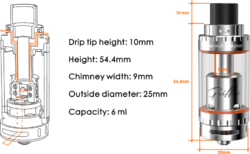Cliffyboy1962
Achiever
- Joined
- Jan 19, 2017
- Messages
- 2,296
I got the Griffin 25 out of the box and set it up last Friday. Coiled wicked and filled her up with some lovely aerovape macaroon.... forgot to close the airflow at the top. 2 mls or so of juice poured straight out the bottom airflow. "Balls".
Just looking at the pictures of the Griffin 25, it looks like the TOP airflow is just supplementary air pulled in through the sides of the top cap, just to give the draw, a more airy feel like on my new Vaporesso Gemini (in fact it looks identical)
IF that is true then these TOP airflow holes can, IN NO WAY, interact with or have any effect on, Juice leaking out the bottom of the tank.The Juice would have had to get past your wicking, onto the deck and down through the Deck airflow holes. The deck of your RTA is at atmospheric pressure as it is open to the chimney. You can't change that. You must have wicked it too loosely ?
Forgive me if I am wrong. Just trying to 2nd guess what happened.
P.S. I just looked at the number of posts you've made and I am guessing I most probably am wrong.
P.S P.S. Just watched the first 30 seconds of a griffin 25 review and Mike vapes said "Top airflow, and not the cheesey type that just takes air from the top, the proper type that gets its air from the coil"
oops. Sorry. Will watch the whole review now.
Having looked at the detailed drawings on the Geekvape website, I cannot see how shutting off the top airflow could possibly affect the juice getting from the tank, onto the deck and down through the bottom airflow holes. The top airflow is just another chimney around the outside of the main chimney and ends up on the deck, just next to the main chimney. When you suck, the air comes in through the bottom airflow holes and down through the seperate top outer chimney.
In fact, looking at it, I would go as far as to say, the air coming in from the top airflow, just goes straight back up the main chimney and doesnt draw any extra air across the coils, but just adds airiness, like my cheesey Vaporesso.
And just one more thing. When you filled her up, didn't you have to remove the whole top cap section anyway ? This would render any discussion about top airflows being open or shut completely irrelevant ! Just saying.
Attachments
Last edited:


















